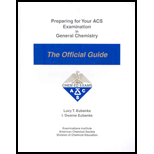
Concept explainers
Interpretation:
The species that has the largest bond angle has to be determined.
Concept Introduction:
Valence shell electron pair repulsion theory (VSEPR) predicts shape of the molecules with the use of arrangement of electrons around central metal atom. Its postulates are as follows:
1. The shape of molecules is governed by the repulsion between electron pairs situated in the outermost or valence shell of the atoms.
2. A distortion is observed in shape of molecules if lone pairs are present in it. These are electron pairs that do not participate in the
3. The order of repulsion of electron pairs is as follows:
4. Multiple bonds create more repulsion as compared to single bonds.
5. The following table shows various molecular shapes that match the different number of electron pairs:
The geometry of the molecule is predicted with help of steric number. The formula to calculate steric number is as follows:
Bond angle is angle that exists between two bonded electron pairs or simply between two bonds. It is angle that is formed between three atoms with atleast two bonds. It is major contributor to shape of molecule and is helpful to predict difference between various geometries of molecules.
Want to see the full answer?
Check out a sample textbook solution
Chapter MS Solutions
Preparing for your ACS examination in general chemistry
- What is the name of the following compound? SiMe3arrow_forwardK Draw the starting structure that would lead to the major product shown under the provided conditions. Drawing 1. NaNH2 2. PhCH2Br 4 57°F Sunny Q Searcharrow_forward7 Draw the starting alkyl bromide that would produce this alkyne under these conditions. F Drawing 1. NaNH2, A 2. H3O+ £ 4 Temps to rise Tomorrow Q Search H2arrow_forward
 ChemistryChemistryISBN:9781305957404Author:Steven S. Zumdahl, Susan A. Zumdahl, Donald J. DeCostePublisher:Cengage Learning
ChemistryChemistryISBN:9781305957404Author:Steven S. Zumdahl, Susan A. Zumdahl, Donald J. DeCostePublisher:Cengage Learning ChemistryChemistryISBN:9781259911156Author:Raymond Chang Dr., Jason Overby ProfessorPublisher:McGraw-Hill Education
ChemistryChemistryISBN:9781259911156Author:Raymond Chang Dr., Jason Overby ProfessorPublisher:McGraw-Hill Education Principles of Instrumental AnalysisChemistryISBN:9781305577213Author:Douglas A. Skoog, F. James Holler, Stanley R. CrouchPublisher:Cengage Learning
Principles of Instrumental AnalysisChemistryISBN:9781305577213Author:Douglas A. Skoog, F. James Holler, Stanley R. CrouchPublisher:Cengage Learning Organic ChemistryChemistryISBN:9780078021558Author:Janice Gorzynski Smith Dr.Publisher:McGraw-Hill Education
Organic ChemistryChemistryISBN:9780078021558Author:Janice Gorzynski Smith Dr.Publisher:McGraw-Hill Education Chemistry: Principles and ReactionsChemistryISBN:9781305079373Author:William L. Masterton, Cecile N. HurleyPublisher:Cengage Learning
Chemistry: Principles and ReactionsChemistryISBN:9781305079373Author:William L. Masterton, Cecile N. HurleyPublisher:Cengage Learning Elementary Principles of Chemical Processes, Bind...ChemistryISBN:9781118431221Author:Richard M. Felder, Ronald W. Rousseau, Lisa G. BullardPublisher:WILEY
Elementary Principles of Chemical Processes, Bind...ChemistryISBN:9781118431221Author:Richard M. Felder, Ronald W. Rousseau, Lisa G. BullardPublisher:WILEY





